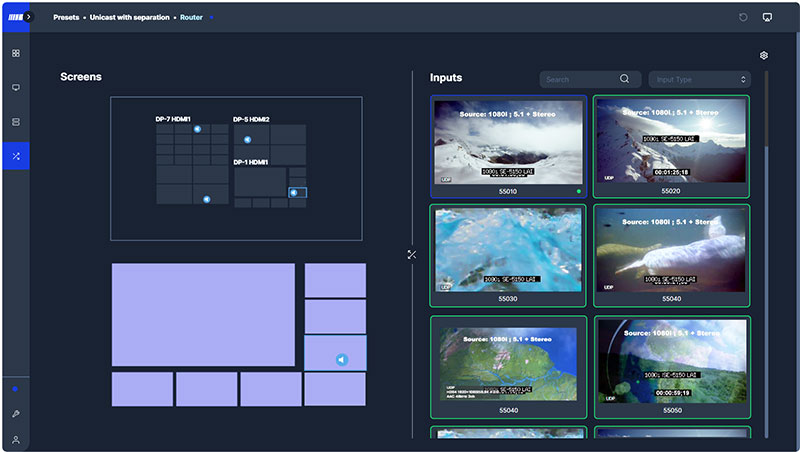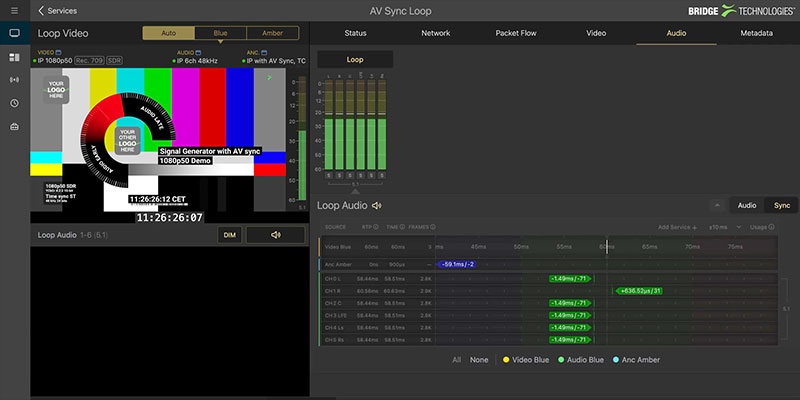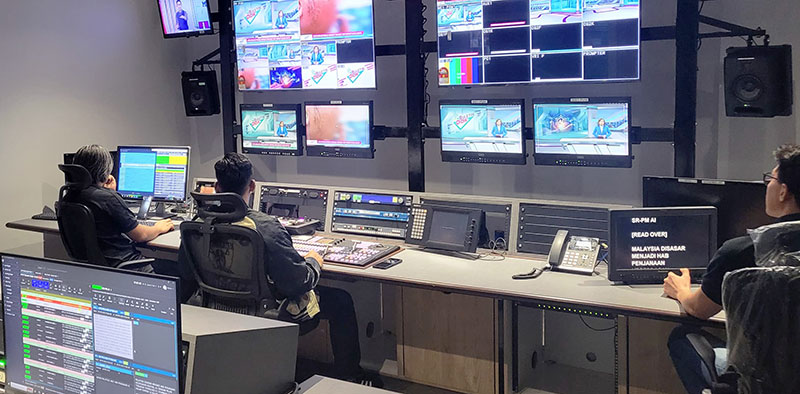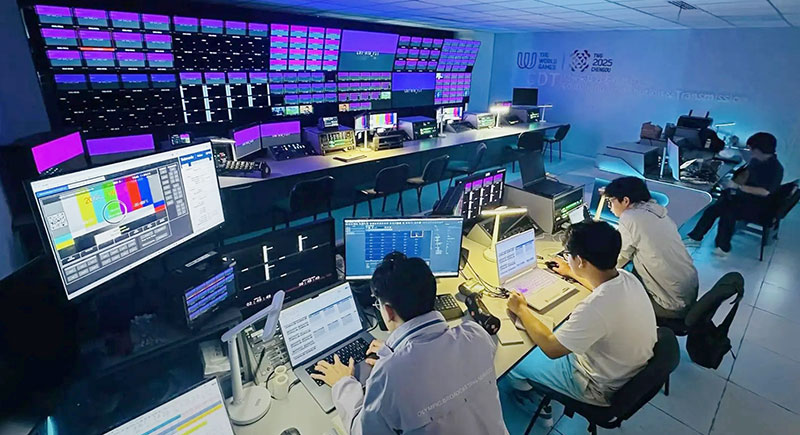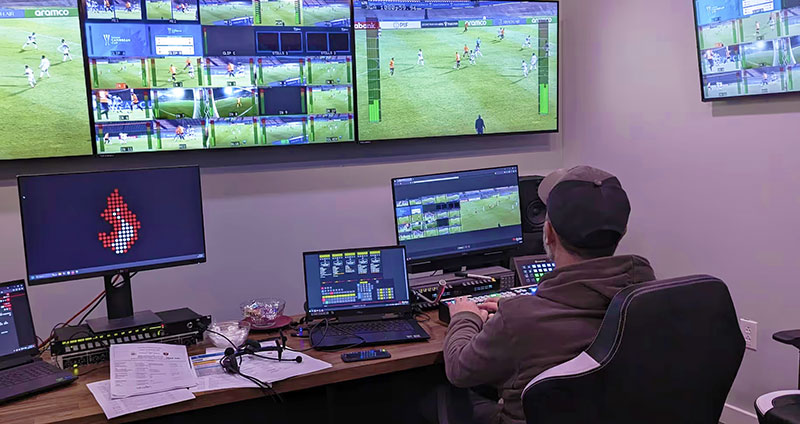NVIDIA’s software-defined, AI-enabled platform helps streaming and broadcast companies take advantage of flexible deployment and adopt new AI tools and features in live media pipelines.

Companies in broadcast, sports and streaming are transitioning to software-defined infrastructure to take advantage of flexible deployment and to more easily adopt new AI tools and features. This transition includes a shift from traditional linear workflows relying on fixed-function devices to flexible and hybrid, software-defined systems that can carry live streaming the future.
NVIDIA Holoscan for Media, now in limited availability, works as an AI-enabled, software-defined platform that allows live media and video pipelines to run on the same infrastructure as AI. Companies with live media pipelines can use applications from established and emerging developers on repurposable, NVIDIA-accelerated, commercial OTS hardware for production and delivery.
Applications may include AI captioning, live graphics, vision mixing, playout server, encode, decode, transcode, multiviewer and NMOS controller functions, with others soon to follow.
Simplify and Optimise
Developers can use Holoscan for Media to simplify their own processes, simplify delivery to customers and integrate emerging technologies and meanwhile optimise R&D costs. In particular, using Holoscan for Media, broadcasters and solution providers can use up-to-date IT and provisioning techniques and a modern container-based approach to development, orchestration and delivery.
The platform integrates widely available, open-source tools to replace proprietary, rigid SDI and FPGA-based systems. Users can also incorporate new developments like generative AI without further infrastructure investments and, of course, Holoscan for Media means the numerous NVIDIA application frameworks and SDKs become accessible for development.

As a single, repurposable platform for many applications, the Holoscan for Media framework has certain advantages for both broadcasters and solution providers, including flexibility because the platform is cloud-native and independent of location – an application can be developed once and deployed everywhere. Provisioning that drives resource sharing could also allow greater scope for sustainability. Overall, less equipment is required, which lowers power and cooling costs and the need for shipping. All of these may lead to a lower cost of operation as well.
Holoscan Tuned for Media
NVIDIA Holoscan itself is an AI computing platform that accelerates full-stack infrastructure required for scalable, software-defined, real-time processing of streaming data running at the edge or in the cloud. It supports camera serial interface and front-end sensors for video capture and data acquisition, and can access AI reference pipelines for streaming video applications.
NVIDIA Holoscan includes optimized libraries for network connectivity, data processing and AI, as well as code examples to create and run low-latency data-streaming applications. Using the SDK, developers can measure end-to-end latency and build pipelines for sensor data processing that meet latency requirements and scale from the data center to the edge.
While NVIDIA Holoscan targets sensor data and media processing applications deployed at-scale across many industries – in the cloud, on premises and at the edge – Holoscan for Media focusses on broadcast and live production workflows – at this stage, on-premises deployments. It includes services such as an NMOS Registry and a graph-builder-based NMOS Controller UI. In turn, these can be installed to support applications that act as media nodes and simplify integration with broadcast facility networks.
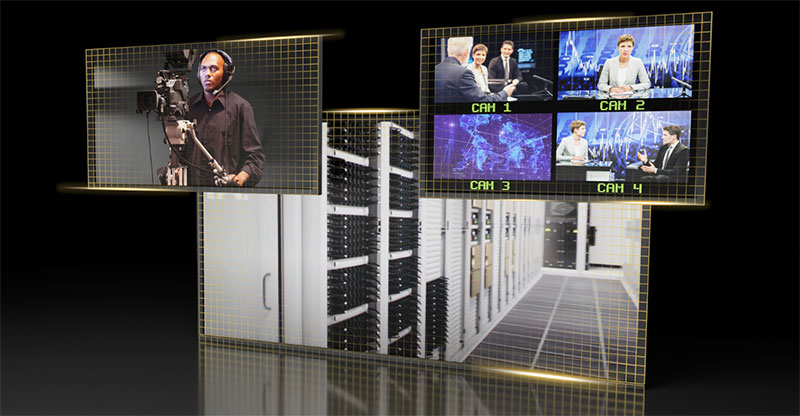
Hardware and Software Foundations – Kubernetes, SDKs, Protocols
The hardware basis of the platform is NVIDIA-certified systems from the company’s partners, aiming for diversity and lower power consumption. The software stack is founded on the open-source Kubernetes container orchestration system, used to automate software deployment, scaling and management. Some Kubernetes management operators allow GPUs to be networked and shared between applications, for instance, and others use the PTP Hardware Clock on NVIDIA DPUs for precise timing between networks and application.
For consistency, applications on the platform are packaged with Helm. Helm operates through Charts that help users define, install and upgrade complex Kubernetes applications. A developer can indicate each container’s required capabilities and resources, including GPU, CPU, memory and storage. The platform can then schedule and monitor applications to make sure each one is appropriately isolated, their requirements are met, and that best use is made of the available hardware.
Developers can build applications using the ongoing list of NVIDIA SDKs supported on the Holoscan for Media platform – full source for a containerized reference application is available, configurable as an NMOS-capable ST 2110 transmitter, receiver or transcoder gateway.
The Holoscan for Media platform is based on industry standard internet protocols, such as ST 2110, and common APIs, meeting strict density and compliance requirements. It includes essential services like Precision Time Protocol (PTP) and NMOS for interoperability and manageability, and is equipped for high-pressure production environments like live broadcast.
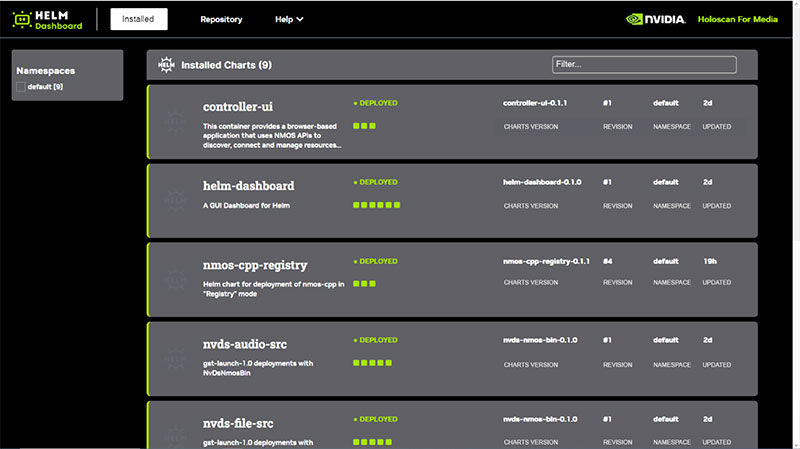
Industry Adoption of NVIDIA Holoscan for Media
Software-defined infrastructure is attracting interest from companies with live media pipelines who want to simplify and speed up their live production and delivery. NVIDIA’s current group of partners who also see the future of the industry heading in this direction include Beamr, Harmonic, Pebble, Qvest, RAVEL, RT Software, Speechmatics and Spicy Mango.
Pebble – Flexible Deployment
Automation, content management and integrated channel specialist Pebble will show support for NVIDIA Holoscan for Media via its PRIMA (Platform for Real-time Integrated Media Applications) platform at IBC2024. PRIMA works directly with Holoscan for Media and supports media and broadcast applications through an underlying Kubernetes and Linux architecture that simplifies implementation on standard hardware on-premises, in the cloud or as a multi-site hybrid deployment.
PRIMA aims for flexible deployment, security, scalability and centralised management. Combined with Holoscan for Media, it helps organisations develop integrated environments based on software and IP connectivity. Together, the two systems create a potential for large-scale, sophisticated, integrated systems built on open standards and interoperability.
By working with NVIDIA, Pebble will support a set of applications for playout, workflow and IP management and control, developing them within the open Holoscan for Media environment, with scope for implementation and continuous evolution.
RAVEL – Automated Orchestration
RAVEL builds DevOps tools for the virtualization and assembly of cloud, on-premises and data centre infrastructure for complex workloads and workflows. Their RAVEL Orchestrate is code-free, DevOps and IT software that automates and rapidly assembles complex software and hardware environments. It includes managing infrastructure, virtualisation, identity management and customized software images.

RAVEL's support for NVIDIA Holoscan for Media means that broadcasters who want to use the NVIDIA platform now have access to a simpler way to set it up. With NVIDIA Holoscan for Media, broadcasters, solutions providers and developers can build live media pipelines that feature AI, and then deploy them across media infrastructures running on NVIDIA-accelerated hardware. But, assembling and deploying NVIDIA Holoscan for Media on such infrastructure is technically demainding, due to the many systems and use cases supported.
To simplify the deployment of NVIDIA Holoscan for Media and its software stack, including Kubernetes, to compatible NVIDIA-accelerated infrastructure in the cloud or on local hardware, broadcasters can now use the automated orchestration tools and intelligent error-checking capabilities in RAVEL’s Orchestrate software.
The first content creator to use RAVEL Orchestrate to deploy NVIDIA Holocan for Media across NVIDIA-accelerated pipelines is Monks, whose customers are looking for ways to meet modern content consumption demands including hyper-personalized content across streaming, social media, VR/AR and others. Using RAVEL Odchestrate saves their developers a huge amount of time, and allows them to scale adequately when delivering Holoscan for Media-based pipelines to customers.
At IBC 2024, Monks will be giving live demonstrations of its NVIDIA Holoscan for Media-based live production pipeline and showing how it deploys Holoscan for Media using RAVEL Orchestrate. www.nvidia.com






